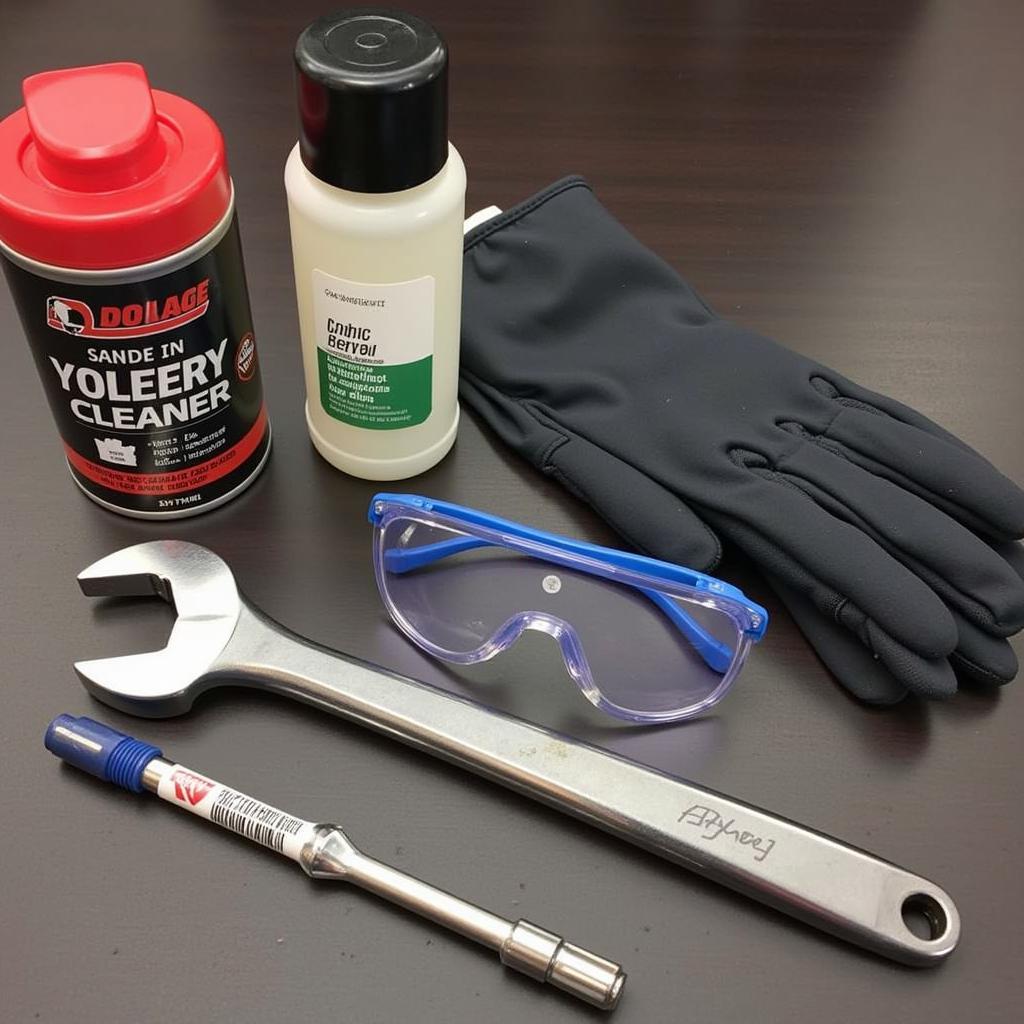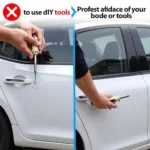Replacing a car battery is a common car maintenance task that many car owners can handle themselves. Knowing the right tools needed to replace car battery ensures a safe and efficient process. This guide will walk you through the necessary tools, safety precautions, and the replacement procedure.
Essential Tools for Car Battery Replacement
Having the correct tools on hand simplifies the battery replacement process and prevents unnecessary delays. Here are the essential tools needed to replace car battery:
- Wrench (usually 10mm or 13mm): This is the most crucial tool, used to loosen and tighten the battery terminals. The size may vary depending on the car model.
- Battery Terminal Cleaner: Corrosion on battery terminals can hinder electrical conductivity. A wire brush or a dedicated battery terminal cleaner tool is essential for removing corrosion.
- Gloves and Eye Protection: Battery acid is corrosive and can cause skin and eye irritation. Always wear protective gloves and safety glasses when working with a car battery.
- Socket Wrench (if needed): Some battery hold-downs require a socket wrench for removal. Check your car’s manual to determine the correct size.
- Dielectric Grease: Applying dielectric grease to the terminals after installation prevents future corrosion and ensures a good connection.
After the initial assessment, having the correct car electrical tools can make a world of difference in the process.
Step-by-Step Car Battery Replacement Guide
Follow these steps for a safe and effective car battery replacement:
- Park Safely: Park your car on a level surface, engage the parking brake, and turn off the ignition.
- Locate the Battery: The battery is usually located under the hood, but some models may have it in the trunk or under the back seat. Consult your owner’s manual if you can’t find it.
- Disconnect the Negative Terminal: Using the wrench, loosen the nut on the negative terminal (marked with a “-” symbol) and carefully remove the cable.
- Disconnect the Positive Terminal: Repeat the process for the positive terminal (marked with a “+” symbol).
- Remove the Battery Hold-Down: Use the appropriate wrench or socket wrench to loosen and remove the battery hold-down clamp.
- Lift Out the Old Battery: Carefully lift the old battery out of the tray, avoiding contact with any metal surfaces.
- Clean the Terminals: Use the battery terminal cleaner to remove any corrosion from the battery terminals and cable connectors.
- Install the New Battery: Place the new battery in the tray and secure it with the hold-down clamp.
- Connect the Positive Terminal: Attach the positive cable to the positive terminal and tighten the nut.
- Connect the Negative Terminal: Attach the negative cable to the negative terminal and tighten the nut.
- Apply Dielectric Grease: Apply a thin layer of dielectric grease to both terminals to prevent corrosion.
- Start the Engine: Start the car to ensure the new battery is working correctly.
Even for easy car maintenance tasks with basic tools, it’s important to be methodical.
Safety Precautions
- Always disconnect the negative terminal first and connect it last.
- Never touch both terminals simultaneously with a metal object.
- Work in a well-ventilated area to avoid inhaling any battery fumes.
- If you are unsure about any step, consult a professional mechanic.
Knowing the right tools and procedures for simple tasks like cleaning a car battery terminal cleaner tool is vital.
Conclusion
Replacing a car battery is a manageable task with the right tools needed to replace car battery and a little know-how. By following the steps outlined in this guide and taking the necessary safety precautions, you can save money and keep your car running smoothly.
FAQ
- How often should I replace my car battery? Typically, car batteries last 3-5 years.
- What are the signs of a failing battery? Dim headlights, slow engine cranking, and clicking sounds when turning the key are common signs.
- Can I jump-start a car with a completely dead battery? It depends on the reason for the dead battery. A jump-start might work if the battery simply discharged, but not if it’s internally damaged.
- Is it necessary to use dielectric grease? While not strictly required, dielectric grease helps prevent corrosion and ensures a good connection.
- What should I do with my old car battery? Most auto parts stores will recycle old car batteries.
Common Scenarios
- Scenario 1: Terminal Corrosion: If the terminals are heavily corroded, you might need a more robust car battery terminal cleaner tool.
- Scenario 2: Tight Battery Hold-Down: A longer wrench or a breaker bar might be needed for stubborn hold-down clamps.
Further Resources
Check out our articles on tools needed for inexperience car owner and car start hand crank tool for more useful information.
For further assistance, contact us via WhatsApp: +1(641)206-8880, Email: [email protected] or visit us at 910 Cedar Lane, Chicago, IL 60605, USA. We have a 24/7 customer service team ready to assist you.


